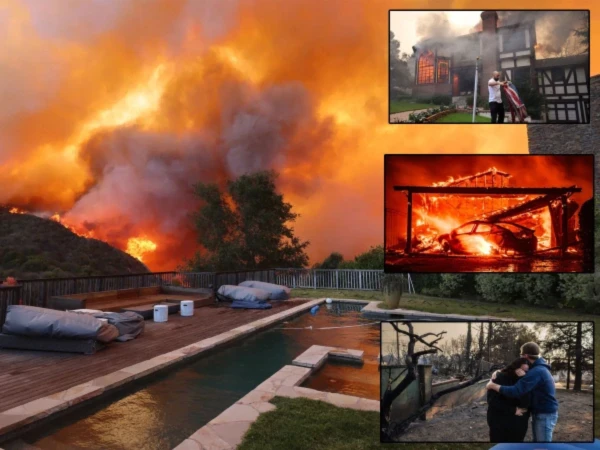Introduction
Every year, the Los Angeles wildfires remind us of nature’s relentless power. These fires, driven by a mix of natural and human factors, leave a trail of destruction that changes lives forever. The smoky skies and charred landscapes tell a story of resilience and adaptation as communities grapple with these devastating events.
Causes of Los Angeles Wildfires

Climate Change and Rising Temperatures
As global temperatures rise, dry conditions create the perfect environment for wildfires. The prolonged droughts in California make vegetation dry and flammable, turning forests into tinderboxes.
Human Activities and Negligence
Unfortunately, human actions often ignite these infernos. Careless behaviors like leaving campfires unattended or improperly discarding cigarettes contribute to the wildfire crisis.
Natural Factors and Wind Patterns
Santa Ana winds play a crucial role in spreading fires rapidly. These strong, dry winds can carry embers miles away, creating new fire outbreaks.
The Immediate Impact of Wildfires

Destruction of Homes and Infrastructure
Wildfires don’t discriminate, consuming homes, businesses, and critical infrastructure. Entire neighborhoods can be reduced to ashes within hours.
Loss of Lives and Wildlife
The toll on human lives is devastating, but the impact on wildlife is equally severe. Many animals lose their habitats, leading to disruptions in local ecosystems.
Health Hazards and Air Quality
The thick smoke from wildfires exacerbates respiratory issues, particularly for those with pre-existing conditions. Poor air quality becomes a region-wide concern, even affecting areas far from the fire zones.
Long-Term Effects on Communities

Emotional Trauma and Mental Health Challenges
Survivors often face PTSD, anxiety, and depression as they rebuild their lives. The psychological scars can take years to heal.
Economic Consequences
Rebuilding homes and businesses comes at a significant financial cost. Many families face years of economic struggle due to uninsured losses.
Displacement and Housing Crises
Displaced families often struggle to find affordable housing, exacerbating California’s already critical housing crisis.
Environmental Consequences

Damage to Forest Ecosystems
Entire forests are lost, affecting biodiversity and the delicate balance of ecosystems.
Soil Erosion and Water Contamination
Without trees to hold the soil, erosion becomes rampant. Ash and debris also contaminate water sources, affecting both humans and wildlife.
Long-Term Climate Impacts
Wildfires release massive amounts of carbon dioxide, further contributing to global warming in a dangerous feedback loop.
Efforts to Combat Wildfires

Firefighting Strategies and Challenges
Firefighters risk their lives battling these blazes. However, unpredictable weather and terrain make their work exceedingly difficult.
Preventive Measures and Community Involvement
Community awareness and fire prevention programs are crucial. Steps like creating defensible spaces around homes can significantly reduce risks.
Government Policies and Support
Federal and state governments are investing in better infrastructure and policies to support fire prevention and recovery efforts.
Stories of Resilience
Inspiring Stories from Affected Families
Families who have lost everything often find hope in starting anew. Their resilience inspires others to stay strong.
Community Support and Solidarity
Neighbors banding together, sharing resources, and supporting each other show the power of community during crises.
Lessons Learned for the Future
Each wildfire season teaches valuable lessons about preparation, response, and rebuilding efforts.
Bangladesh in Turmoil: Sheikh Hasina’s Flight to India and the Future of Indo-Bangladesh Relations
The Role of Technology in Managing Wildfires

Drones and Satellite Monitoring
Technology like drones and satellites is improving fire detection and monitoring, giving firefighters an upper hand.
AI in Predicting Wildfire Patterns
AI algorithms are helping predict fire spread, enabling more efficient resource allocation and response.
Innovations in Fire Suppression Techniques
New fire suppression tools, such as fire-retardant gels and advanced water delivery systems, are making a difference.
Conclusion
The Los Angeles wildfires are more than a seasonal challenge—they are a wake-up call. As we adapt and rebuild, it’s essential to address the root causes and support affected communities. Together, we can create a future where wildfires are less destructive and recovery is quicker.
FAQs
- What causes wildfires to spread so quickly?
Factors like dry vegetation, strong winds, and high temperatures make wildfires spread rapidly. - How can communities prepare for wildfires?
Creating defensible spaces, having evacuation plans, and staying informed are key steps for preparedness. - What are the long-term health effects of wildfire smoke?
Prolonged exposure to smoke can lead to chronic respiratory issues and cardiovascular diseases. - How do wildfires impact wildlife in the region?
Wildfires destroy habitats, leading to loss of biodiversity and disruption of ecosystems. - What role does climate change play in increasing wildfires?
Climate change exacerbates conditions like drought and heat, making wildfires more frequent and intense.



1 thought on “Raging Flames: How the Los Angeles Wildfires Are Changing Lives Forever”